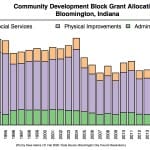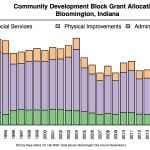$800K in federal community development fund allocations OK’d by Bloomington city council



At its regular Wednesday meeting this past week, Bloomington’s city council approved allocations for $800,000 worth of federal Community Development Block Grant (CDBG) funds.
Doris Sims, who’s director of the city’s HAND (Housing and Neighborhood Development) department led off the presentation to the city council on the resolution.
The amount awarded by the federal Department of Housing and Urban Development could turn out to be more than $800,000. If additional funds turn out to be available, the resolution approved by the city council allocates the extra money based on a priority ranking of programs that were not fully funded, or funded at all, in the basic allocation.
One example of a program that applied for but was not allocated any funds in the basic allocation, was New Leaf New Life, a non-profit that supports those who are coming back to the community after being incarcerated. Another non-funded group this year was Middle Way House, which operates programs to address domestic violence.
The CDBG allocations are made annually. The recommendations for allocations come from a citizens advisory committee (CAC) made up of two city council members, two redevelopment commission members, and up to 18 community members appointed by the mayor.
Social services programs receiving allocations this year were Community Kitchen ($25,000), Mother Hubbard’s Cupboard ($22,500), Hoosier Hills Food Bank ($25,000)
Boys & Girls Clubs of Bloomington ($25,000), and Monroe County United Ministries ($22,500).
Councilmember Susan Sandberg, who served on the CAC, said at Wednesday’s meeting that the CDBG money is tough to allocate. Another funding possibility for programs that did not receive a CDBG allocation, Sandberg said, is through the city council’s Jack Hopkins social services funding committee. This year’s first Jack Hopkins meeting takes place on Feb. 27.
It’s not an accident that the $120,000 allocated to social services programs works out to 15 percent of the $800,000 total. HUD rules say that social services programs can’t receive any more than 15 percent of the funds. Under HUD rules, administration can’t receive any more than 20 percent. Bloomington’s allocations also max out the administrative component.
Under HUD rules, at least 65 percent of the allocation has to go towards infrastructure improvements. Bloomington’s allocation this year matches that exactly: $520,000.
Among the physical improvement projects that was allocated funding this year, was $117,000 for W. 14th Street pedestrian improvements. It was a project that drew councilmember Dave Rollo’s attention during Wednesday’s meeting, because the same project was recommended for an allocation from the city’s alternative transportation fund by the city council’s sidewalk committee three weeks ago. Rollo serves on the sidewalk committee.
The sidewalk committee’s recommendation to fund the 14th Street sidewalk project assumed some CDBG funding—more than was actually awarded. Asked by Rollo if it would be sufficient, deputy council attorney/administrator Stephen Lucas said it would be.
The CDBG funds were not controversial among city councilmembers. Councilmember Isabel Piedmont-Smith highlighted a “whereas” clause that she thinks is important as the city approaches the redevelopment of the IU Health hospital site on 2nd Street and the K-Mart site:
Whereas, the integration of income groups throughout the community by spreading persons of lower income into more prosperous neighborhoods and drawing persons of higher income to declining and deteriorated neighborhoods; …
The delineation of different housing types into separate sections of the project has been one of the few points of dissatisfaction for some of the council’s land use committee members in their consideration of a planned unit development (PUD) proposal from Trinitas, southeast of the I-69 and SR 46 interchange. The land use committee meets for a second time about the Trinitas project on Feb. 26.
Eric Sader, assistant director of the city’s HAND department (Housing and Neighborhood Development) said on Wednesday that going back to 1989, Bloomington has received over $28 million in CDBG funds.
Based on a Square Beacon review of city council resolutions approving CDBG funding, the total CDBG funding allocations in approved resolutions for a slightly shorter period, since 1991, is: $27,903,357.
The breakdown of that amount is $5,274,840 for administration, $18,459,563 for physical improvements, and $4,168,954 for social services.
Sader said that the CDBG funding has been proposed for complete elimination in the last few presidential budgets, but has been restored by Congress each year.




Comments ()